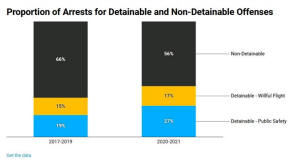Contextualizing cash bail’s end
 Send a link to a friend
Send a link to a friend
[November 05, 2022]
By JERRY NOWICKI
Capitol News Illinois
jnowicki@capitolnewsillinois.com
 SPRINGFIELD – While a new law overhauling
Illinois’ system of pretrial detention continues to face scrutiny ahead
of its Jan. 1 implementation date, new research suggests that the old
cash-based system “results in much less pretrial detention than is
generally assumed.” SPRINGFIELD – While a new law overhauling
Illinois’ system of pretrial detention continues to face scrutiny ahead
of its Jan. 1 implementation date, new research suggests that the old
cash-based system “results in much less pretrial detention than is
generally assumed.”
That’s according to the Loyola University of Chicago Center for Criminal
Justice, which has been measuring the potential effects of the provision
commonly referred to as the Pretrial Fairness Act, which will abolish
cash bail come Jan. 1.
“What we’ve found is that, while it’s true that many people are jailed
under the current cash bail system, most jail stays are brief,”
researchers wrote in an Oct. 26 brief that examined data from six
counties. “Most people pass through jails, being held for relatively
short periods before bonding out — and that includes people charged with
the kinds of serious offenses that are designated ‘detainable’ under the
PFA.”
The research is nonpartisan and not conducted for advocacy purposes. It
received funding from the National Institute of Justice, which is a
research arm of the U.S. Department of Justice.

David Olson, a Loyola professor and Center co-director, spoke to Capitol
News Illinois for an episode of the Capitol Cast podcast. Below is a
list of questions covered in the conversation, along with other context
from CNI’s previous reporting on the topic.
How will pretrial detention change under the new law?
The PFA, passed in 2021 as part of the SAFE-T Act criminal justice
reform, will end the wealth-based system that decides whether an
individual is released from custody while they await trial.
It replaces it with one that allows judges greater authority to detain
individuals who are accused of violent crimes and deemed a danger to the
community or a risk of fleeing prosecution. But the new system also
limits judicial discretion when it comes to lesser, non-violent
offenses.
Under current law, bail hearings typically occur within 72 hours of
arrest and last fewer than five minutes. Prosecutors detail the
defendant’s charges and may recommend a bail amount. The judge then
decides the conditions of their release, including how much money, if
any, the defendant must post before their release.
“The concern is that in in some counties, there's not sufficient time
spent considering the decision at hand, …there isn't adequate or
sufficient legal representation at that point where an important
decision about liberty is being made,” Olson said.
The PFA, he said, was designed to make detention hearings more
deliberative.
That’s important, he said, because the subjects of the law are
defendants who have only been charged with, not convicted of, a crime.
The new process will allow a prosecutor to petition the court for
pretrial detention and a defendant is given the right to legal
representation at their first hearing, with the detention hearing
typically taking place within 24 or 48 hours of the first appearance in
court.
Will more defendants walk free while awaiting trial because of the
new law?

Olson said the research can’t predict whether more or fewer people will
be jailed while awaiting trial once the PFA takes effect, but the makeup
of jail populations is likely to change. It’s likely, researchers found,
that lower-level defendants will spend less time in jail, while stays
may get longer for those accused of violent crime because they can no
longer free themselves on bail.
One study estimated that a judge would not have been able to detain the
defendant in 56 percent of arrests that occurred statewide in 2020 and
2021 had the PFA been in place.
But another analysis showed only 19 percent of individuals with pending
felony cases were in jail custody while awaiting trial on average from
2017 through 2019, with another 17 percent on electronic monitoring or
pretrial supervision.
That means about 64 percent of individuals awaiting trial for felony
charges over that timespan were living in the community without any sort
of supervision, the study found.
“The important caveat to that, and I think what the law seeks to
address, is that they spend some time in jail,” Olson said. “And even if
they spent a few days in jail, it's disruptive to their life. And we
didn't really achieve anything if we were thinking we were achieving
public safety, because we only held them for one or two days before
(they posted bond).”
Another study of Cook County data showed individuals charged with an
offense that would be non-detainable under the PFA paid an average of
$1,646 to be released from jail in 2021. Individuals who could be held
as flight risks under the PFA were required to pay an average of $4,846,
while those detainable as risks to the community under the PFA could pay
an average of $5,344 for release from jail.
So what are “detainable” offenses?
Under the PFA, police will maintain discretion to arrest and bring to
the station any individual who is charged with a crime and deemed a
threat to the public.

What’s new is that the law will create a presumption in favor of
pretrial release for any individual charged with offenses for which a
judge cannot deny pretrial release. That means officers are instructed
to cite and release lower-level offenders who, under the officer’s
discretion, are not deemed a threat to the community. They would be
given instructions to appear in court within 21 days.
Once an individual is arrested, prosecutors may petition the court for
pretrial detention. Once a judge receives that petition, their decision
to detain would hinge on whether the state has proven “by clear and
convincing evidence” that the defendant has committed a detainable
offense.
Detainable offenses include non-probationable forcible felonies such as
murder, aggravated arson, residential burglary, stalking, domestic
battery, offenses where the abuse victim is a family or household member
or if the defendant was subject to the terms of an order of protection,
gun offenses and several specified sex offenses.
Persons deemed to be “planning or attempting to intentionally evade
prosecution” may also be detained pretrial under what is called the
“willful flight” standard if they’ve been charged with a crime greater
than a Class 4 felony – such as property crimes, aggravated DUI and
driving on a revoked license.
[to top of second column]
|

Research from the Loyola University of
Chicago's Center for Criminal Justice examines how arrests in recent
years would have been categorized under the Pretrial Fairness Act
that ends cash bail beginning Jan. 1, 2023. (Credit: loyolaccj.org/pfa)

Olson noted the detention standards create a greater likelihood that
individuals accused of domestic violence remain in jail than under
current law. That’s one reason domestic violence victim advocacy groups,
which helped craft the law, remain among its most ardent supporters.
“When we get to the domestic violence offenses, currently, they are
detained to a degree but most post bond within a relatively brief period
of time,” he said. “So it may be under the law that more of them stay in
pretrial detention for a longer period of time.”
How is judicial discretion limited by “non-detainable” offenses?
Under the PFA, there are no offenses that would be non-detainable in
every circumstance. Even misdemeanors and other low-level offenses can
result in detention if the defendant is already on pretrial release,
probation or parole.
But for the most part, the law prohibits detention of individuals
accused of committing lower-level, non-violent offenses. Olson used the
example of vandalism, criminal trespass where the defendant is not
deemed a threat, “someone stealing a six pack of beer,” small-amount
felony drug possession or low-level retail theft offenses.
There are many levels of nuance to detainability, Olson added. For
example, he noted, a homeless person who steals a purse might not be
detained on robbery charges because it would be difficult to prove them
to be a risk of willful flight. But an armed robbery with a firearm
would be a detainable offense under the dangerousness standard.
“Most arrests in Illinois are for relatively minor crimes,” he said.
“It's not the crimes that get much attention from the media or the
public, but most arrests are for relatively minor crimes. And so the
idea is divert those from the formal trappings of this process that take
time and resources.”
Olson noted judges in many counties will have more options for setting
release conditions for all defendants come Jan. 1 when the Illinois
Supreme Court launches its Office of Statewide Pretrial Services in
about 70 counties that don’t currently offer such services.

Pretrial services and supervision can range from sending reminders about
court appearances, to mandating monthly check-ins to confirm a
defendant’s address, to providing transportation, to overseeing
individuals placed on electronic monitoring.
Supervision may also include court orders for counseling or treatment
programs and requiring face-to-face reporting to a pre-trial service
officer.
Why not give judges greater authority to detain all individuals?
A frequent argument against the PFA from prosecutors and Republicans is
that the new detainability standards are too limiting for judges. Some
have requested Illinois implement a system similar to one adopted in New
Jersey in 2017 which allows judges to detain even for misdemeanor
crimes.
They’ve also argued that the standard for proving willful flight is too
high and some sections of the new law are contradictory, creating wider
categories of “non-detainable” offenses than the bill’s drafters
intended.
Olson noted the question of where to draw the line on judicial
discretion is important because of the finality of pretrial detention
under the new system.
“Now, the stakes are a lot higher, right?” Olson said. “The decision to
detain is a decision to detain, it's not a wishy-washy on-the-fence of
well, ‘We're going to hold you but if you can come up with $1,000,
you're free.’ This is a decision about freedom. And so I think with that
the argument by many is that detention should be more constrained.”
By providing lower-level offenders with a citation and scheduling them
to appear in court within 21 days, Olson said, the intent of the law is
to allow officers to go back to the beat rather than booking an
individual, and to allow the courts to spend more time on cases where
violence was involved or was likely to be involved.
It’s also something that, research has shown, has already been happening
more frequently since the COVID-19 pandemic began.

Olson said the first hearing for cited-and-released individuals would be
brief and would not focus on an individual’s detention, although a judge
could set conditions of pretrial release or pretrial supervision.
What could change about the new law before Jan 1?
Judicial discretion is a matter that could be reconsidered when
lawmakers return to the Capitol on Nov. 15.
A follow-up bill sponsored by former prosecutor and current Democratic
Sen. Scott Bennett, of Champaign, would, among other things, widen
judicial authority to allow for detention of a defendant charged with
any crime if the court believes they are a serious risk of skipping
trial, pose a danger to the community, or are likely to threaten a
potential witness or juror.
That’s a bill that Gov. JB Pritzker has said could be a launching point
for discussions as lawmakers consider amendments to the PFA, although he
has not endorsed all of its components.
The bill’s House sponsor and domestic violence victim advocacy groups
have pushed back against that specific provision, arguing that it would
overburden the court system and divert resources from more serious cases
where a person’s freedom is on the line and they’re accused of violent
crime.
Olson agreed that by expanding detainable individuals from roughly half
of those arrested to all individuals entering the system, the intent of
the law would be drastically changed by the proposed amendment.
Will those held in lieu of bail on Jan. 1 be freed under the PFA?
Nothing in the bill says that will happen, although opponents of the PFA
have cited its silence on the matter as a point of concern. Pritzker
said he would like it made explicit in a follow-up bill that individuals
held in lieu of bail when the bill takes effect will not be released.
Capitol News Illinois is a nonprofit, nonpartisan news
service covering state government. It is distributed to more than 400
newspapers statewide, as well as hundreds of radio and TV stations. It
is funded primarily by the Illinois Press Foundation and the Robert R.
McCormick Foundation.
 |